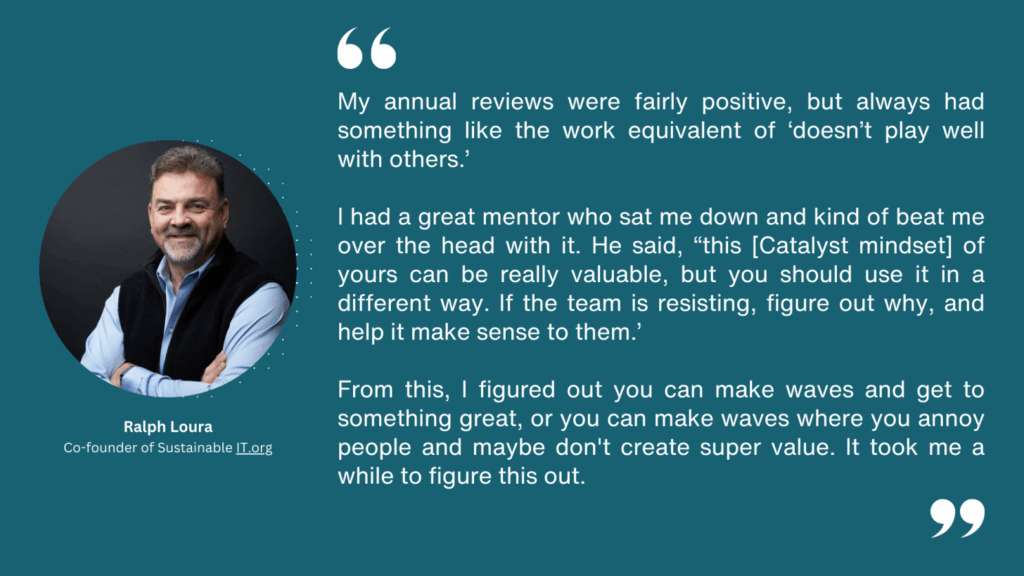The term “innovation” often becomes a catch-all that fails to drive real business impact. The most successful organizations define innovation precisely to deliver their corporate vision, and build a culture around this understanding. Here’s how to ensure your innovation efforts deliver measurable results.
Key Takeaways
- Innovation means something different in every organization; clarify what it means in yours to foster a culture that delivers results instead of frustration.
- When you clearly define innovation, you can enable, reward and measure team activities that drive your vision of success.
Get inspired by serial CIO Ralph Loura’s journey from delivering on to defining innovation cultures in our podcast Catalytic Transformation is 99% Mindset.
Start with What
Fostering a culture of innovation is leadership’s way to focus Catalysts and ensure meaningful change and growth that is aligned with your vision and strategy. But, before you can foster that culture, you have to crystallize what innovation is.
“Innovation” can mean everything and nothing. Without a precise definition, Catalysts will burn out themselves and everyone around them, working ideas and acting in ways that may work great in one organization but fall flat in yours. So, what should your culture of innovation look like? Different organizations define it differently. It could be:
- An openness to new ideas and ways of working,
- Bringing new market opportunities to leadership, or
- Investing a set amount of time exploring future-looking opportunities
Or – it could be something else entirely.
Step one is to define innovation. What types of innovation are important to you? Are there particular elements of your business you are looking to transform? Are there specific outcomes or goals that should be identified related to innovation or transformation?
Last November, we sat down with Ralph Loura, former CIO at HPE and Clorox and Co-founder of Sustainable IT.org, to discuss insights from his personal Catalyst journey. Ralph provided great examples of how to foster a culture of innovation, from both sides of the leadership seat.
In an early role at Bell Labs, Ralph was inspired by a mentor who knew that Ralph’s Catalyst instincts were valuable, but would burn out Ralph and everyone around him unless he had guidance on what was valuable to the organization.

After you know what type of innovation culture you’re trying to build, you can determine how best to achieve it.
From What to How
With innovation defined, think about how your innovation culture should manifest itself in team behavior. Break down the skills that are helpful to the way you’d like innovation to take root. This is where your organization’s clarity on what innovation is and what it will bring to the organization is critical.
“Nobody shows up to work every day thinking, “How can I make this harder?’” – Ralph
Let’s work with the first type of innovation – embracing openness to new ideas and ways of working – as an example. The skills to nurture and reward this innovation outcome could include openness, flexibility, agility and growth mindset; avoiding knee-jerk resistance or naysaying. In this example, leaders would teach and share examples of how to shift from resistance to openness.
Conversely, bringing new market opportunities to leadership may require instruction on market sensing and collecting market data, or how to frame a problem and create a vision others can engage with.
This clarity makes it easier to align the culture and build the skills that drive innovation, but it doesn’t happen without mindful, intentional communication.
Communication Is Key
Start by communicating, in a formal way, that innovation is important. Add it as a corporate value or core principle. Make innovation – your type of innovation – a part of how you define yourself as a company.
Posters on walls are great, but it can’t stop there. You must regularly reinforce your innovation culture with layers of communication.
Highlight where innovation is being lived regularly. Share specific examples of innovation activity in your all-hands updates and annual meetings. Establish a quarterly peer reward program and take every opportunity for informal shout-outs. All of these are great tools to reinforce innovative behaviors from different directions, creating a holistic environment of both safety and expectation.
Later in his career, when he was CIO at Symbol Technologies, it was Ralph’s turn to focus the team while creating the space for innovation. He was charged with completely overhauling the supply chain, reporting and product lifecycle management processes – and he learned a big lesson in building innovation culture:
“We created an internal marketing campaign called, ‘imagine a Symbol where…’ sharing all these things we were trying to accomplish. We had this big launch, and we went through a half day event. And the team – didn’t get it. I was frustrated.
John Bruno, our CMO, pulled me aside and said, ‘how long did it take you to get to this point of clarity? You’ve been working on the campaign for four months and then you give them four hours to get there.
They needed time to catch up, so I spent a bunch of time working on mindset – working on getting them caught up and on board. How will we do this? Why do I believe that? Connecting all the dots, and that made a huge difference, and we delivered.” – Ralph
Measure What Matters
Finally, measure how and where innovation is taking hold. This could be how many new ideas come to leadership, or how many new ideas are implemented. Or it could be a metric on how open and agile team members are. You need data to understand whether you are or aren’t changing to help course correct actions and share progress with the team.
But truly successful innovation also requires concrete metrics tied to business outcomes. Focus on things like:
- Revenue impact from new initiatives
- Operational efficiency gains
- Customer satisfaction improvements
- Employee engagement scores
- Speed to market for new offerings
With measurement, you can also add rewards for team members who are embracing your innovation culture.
A culture of Innovation is a living, iterative way of being that should reward effort and expression as well as more tangible outcomes.
Leading the Innovative Culture
Innovation delivers value when it’s clearly defined, properly resourced, and measurably tied to strategic objectives. The key is identifying and empowering the right people within your organization to drive these initiatives forward.
Want to learn more about driving strategic innovation in your organization? Access our latest research and insights:
- Full Interview with Ralph Loura: https://podcast.catalystconstellations.com/ralph-loura-co-founder-of-sustainable-itorg-and-former-cio-catalytic-transformation-is-99-minds/
- Reimagining strategic planning for 2025 research report: https://mc.catalystconstellations.com/cltlatestresearch
- Transformation Acceleration Program Overview: https://mailchi.mp/925248c20bf9/catalystprogram
Contact us to discuss how we can help you achieve your boldest strategic initiatives.




